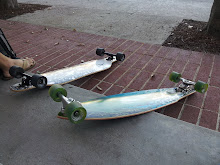Don Ihde’s chapter, “In Praise of Sound,” provides a comprehensible outline of visuality’s domination over sound in the gathering of knowledge and information, and the proclamation of truth in Western culture since the ancient Greeks. Ihde efficiently summarizes the arguments for obtaining truth and knowledge through the senses, weaving an enjoyable story reaching back to the ancient Greek philosophers and making the reader think about something as “natural-feeling” as using vision in order to ascertain information as a socially constructed way of viewing the world. The tension between a reduction to vision and a reduction of vision is an interesting one. After all, seeing is believing, but people see/sense differently. Just biologically, someone could be near-sighted, far-sighted, blind, colorblind, have cataracts, or any of the other numerous ways that differentiate how different individuals perceive the world through sight, sound, or the other senses. The arguments Ihde highlighted and presented in the piece insightfully laid out the different positions and progressions between the two philosophies, even touching on the fact that modern metaphysics remained cynical to the senses, instead relying on reason, the unsensed, that transcends the senses. Following this argument, how Ihde would reconcile the idea of relying on the unseen with the existence of God. Science and religion has frequently been at odds with each other in the modern age, starting with Galileo and Copernicus coming down on the bad side of the Church by espousing their scientific findings (even though that was not their intention). Even in today, we so quickly accept science as truth and remain cynical of religion and faith. In this case, both science and faith (or God) are relatively unseen. How many of us have physically seen the composition of a hydrogen molecule, an electron, or a neutrino? How many of us have seen, with a naked eye, a black hole? And yet, science tells us they exist. Is this not the same as believing in an unseen superior being?
Ihde states that “by living with electronic instruments our experience of listening itself is being transformed, and included in this transformation are the ideas we have about the world and ourselves.” (pg. 5) Indeed, placing it in context of technological advancements and the way the visual and the aural have been intertwined with each other (and with other senses, although Ihde did not travel as much down that path). After all, it is through technological advancements that we are able to record and reproduce aural signals. Prior to the phonograph, the only way information and knowledge was recorded was through the written. Take a look at music. In order for music to have been passed through time and space, it needed to be written down. We will never know exactly how the Turkish March sounded when Mozart played it, because Mozart’s life predates the phonograph. But we have the Turkish March as a visual representation of the aural, and we are able to (at least technically) replicate Mozart’s intention for how a song should sound.
Ironically, in today’s electronic and recording heavy world, we have lost the practice of putting songs into the symbol of the musical language. We have lead sheets and chords and tabs for pop songs today, yet there are rarely written musical notations readily available to the public to reproduce exactly how a song like Britney Spears’ “Oops, I Did It Again” was played on the album. Instead, electronic technology has enabled audio editing in order for a performance to be created piecemeal, then pieced together to create one composite and seemingly singular auditory experience.
The history of the visual as a modality for information is longer than that for audio. The written allows information to be passed through time and space, the aural exists in the now and is temporally bound. Even today, we ask that important information be put “on paper” so it can be referenced at a future date, or at a different location. The visual becomes equated with evidence, with truth. However, as technology has advanced to give us sound recording, and ways to analyze the sound recordings, aural signals have slowly started becoming a basis for evidence. New details in Robert F. Kennedy’s shooting came to light through an analysis of a sound recording taken the day of his assassination (). Here, sound is the key player in uncovering the “truth.” But this would not have been possible before the advent of sound recording.
Ihde closes his argument eloquently by stating that the examination of sound is not to replace the visual with the aural, but to “move toward a radically different understanding of experience, one which has its roots in a phenomenology of auditory experience.” (pg. 15) This leads me to question, though, if there is a push for the understanding of experience rooted in the phenomenology of the aural because of the visual’s domination in the way our society comes to knowledge. Can we ever talk about sound without reference to the visual because the visual has been dominant? Is it like trying to talk about race without reference to white superiority, or queer studies without bearing in mind the reality of heteronormativity?




No comments:
Post a Comment